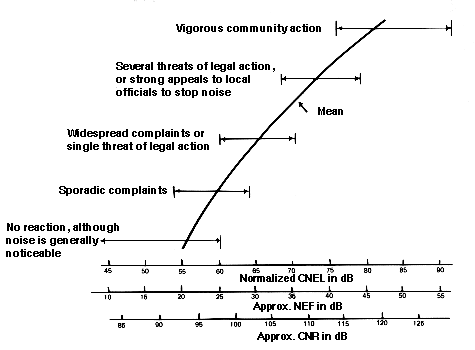A noise measurement system introduced in the early 1970's by the State of California as a simplified alternative to the NEF system (see NOISE EXPOSURE FORECAST) for community noise exposure, with particular emphasis on airport noise. The major difference is that CNEL can be measured using ordinary dBA readings (see SOUND LEVEL METER), as opposed to the computer calculation of EFFECTIVE PERCEIVED NOISE LEVEL used in the NEF.
As well, the CNEL system gives a higher weighting to evening flights (1900 to 2200) and includes a table of corrections (see below) based on seasonal, residential type, previous community noise experience and pure tone/impulse differences. In practice, CNEL values are comparable to NEF and exceed them by 35 ± 2 dB. The total noise exposure per day (CNEL) is calculated from the equation:
where ND, NE and NN are the number of flights during the day (0700 to 1900), evening (1900 to 2200) and night (2200 to 0700) respectively, and SENEL is the energy mean value of the single event noise exposure level which may be calculated from the equation:
where NLmax is the maximum noise level in dBA and tea, is the effective time duration (in seconds) of the noise level (on the A scale) and is approximately equal to one-half of the duration during which the noise level is within 10 dB of the maximum.
The above expressions are simplifications of the actual procedure and only apply to a single type of aircraft and single flight path. An hourly average of the noise level (HNL) including number of flights per hour N is also used and defined as:
A variation in the calculation uses the first equation above but counts the flights as in the NEF system (without evening specification). The normalized CNEL uses the corrections listed in the table below (see also SOUND INTRUSION). Correlation to community reaction is shown in the following chart for the CNEL scale (with approximate CNR and NEF values).
Compare: NOISE AND NUMBER INDEX, NOISE CRITERION, NOISE EXPOSURE FORECAST, NOISE LEVEL, NOISE POLLUTION LEVEL, NOISE RATING, PERCEIVED NOISE LEVEL, SPEECH INTERFERENCE LEVEL.
|
Type of Correction |
|
Amount of Correction to be Added to Measured CNEL in dB |
|
Seasonal Correction |
Summer (or year-round operation) Winter only (or windows always closed) |
- 5 |
|
Correction for Outdoor Residual Noise Level |
Quiet suburban or rural community (remote from large cities and from industrial activity and trucking) |
|
|
Normal suburban community (not located near industrial activity) |
|
|
|
Urban residential community (not immediately adjacent to heavily traveled roads and industrial areas) |
|
|
|
Noisy urban residential community (near relatively busy roads or industrial areas) |
|
|
|
Very noisy urban residential community |
|
|
|
Correction for Previous Exposure & Community Attitudes |
No prior experience with the intruding noise |
|
|
Community has had some previous exposure to intruding noise but little effort is being made to control the noise. This correction may also be applied in a situation where the community has not been exposed to the noise previously, but the people are aware that bona fide efforts are being made to control the noise. |
|
|
|
Community has had considerable previous exposure to the intruding noise and the noisemaker's relations with the community are good. |
|
|
|
Community aware that the operation causing noise is very necessary and it will not continue indefinitely. This correction may be applied for an operation of limited duration and under emergency circumstances. |
|
|
|
Pure Tone or Impulse |
No pure tone or impulsive character |
|
|
Pure tone or impulsive character present |
|
Table of correction factors used to normalize CNEL values (after U.S. Environmental Protection Agency document NTID300.3, Community Noise, 1971).

Community reaction to noise as a function of normalized CNEL values as calculated from case histories (after U.S. Environmental Protection Agency document NTID 300.3, Community Noise, 1971).
home